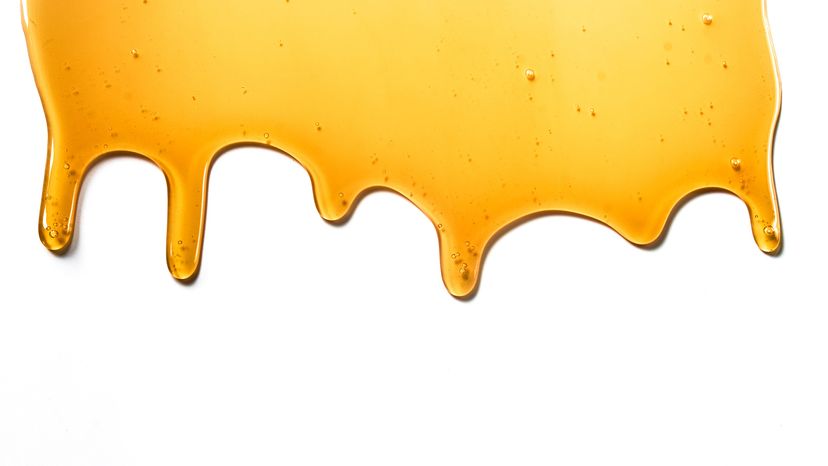It’s all fun and games until someone spikes the honey. Ekaterina Goncharova / Getty Images
There’s a peculiar type of honey, called mad honey, that contains a neurotoxin. In small doses, it can cause hallucinations, but in large amounts, the substance can be highly poisonous. Over the centuries, people have used it as a medicinal drug, a recreational drug and even a bioweapon.
But what makes mad honey so different from the regular honey you can find in your grocery store? Let’s examine what gives this naturally occurring substance its unique properties and how people still use it today.
What Is Mad Honey?
The natural substance called mad honey (or “deli bal” in Turkish) is simply honey produced by bees that gather nectar mainly from the flowers of certain rhododendron species, particularly Rhododendron ponticum. These flowers contain grayanotoxin, a neurotoxin with psychoactive effects that’s toxic to humans in high doses.
When bees collect nectar from these rhododendron flowers, they transfer the grayanotoxin to the honey they produce, giving it hallucinogenic properties. Local honey hunters then collect and distribute this hallucinogenic honey.
Mad honey differs from regular commercially available honeys (including raw honey) in that regular honey does not contain grayanotoxin and therefore does not produce honey-induced hallucinations.
When it comes to the availability of mad honey, Nepal and Turkey are famous for producing the curious substance. While it’s legal to purchase mad honey in the United States, other countries like Australia and South Korea have banned the hallucinogenic honey.
Nepalese mad honey can fetch as much as 80 USD per pound on the black markets in such countries.
Mad Honey Disease
While mad honey may appeal to curious minds and adventurers, mad honey consumption can lead to a condition known as mad honey poisoning, characterized by nausea, vomiting, dizziness, blurred vision and low blood pressure.
In rare cases, consumption of too much mad honey can even result in more severe effects, including cardiac problems and temporary paralysis.
Mad honey poisoning is essentially grayanotoxin poisoning. When eating mad honey, a person introduces grayanotoxin into their bloodstream. At higher doses, this toxin interferes with voltage-gated sodium channels in the body, which normally play a crucial role in the transmission of nerve impulses and the regulation of muscle contractions.
By binding to sodium channels, grayanotoxin disrupts these functions, leading to alterations in membrane permeability and the flow of sodium ions across cell membranes.
In the heart, this interference with sodium channels can result in rhythm disorders, such as bundle branch block, where the electrical signals in the heart’s conduction system are delayed or blocked.
A person’s body might experience transient ST segment elevation — a temporary abnormality observed on an electrocardiogram (EKG) — or nodal rhythm, an abnormal heart rhythm originating from the atrioventricular (AV) node, which regulates the timing of electrical impulses in the heart.
While grayanotoxin poisoning is rarely fatal, it can cause significant discomfort.
Historical Military Experiences With Mad Honey
There are a few famous historical examples of armies ingesting mad honey. In 401 B.C.E., some Greek soldiers who stole and ate honey from beehives as they marched through Turkey became so ill they were forced to halt their travels for a few days.
Another instance saw mad honey’s use as an ancient biological weapon. In 67 B.C.E., the Persian army intentionally left behind large quantities of mad honey for an army of advancing Roman soldiers to find. After they suspected the Roman army had enjoyed their rhododendron honey, the Persians returned and slayed the disoriented Roman troops easily.
Traditional Uses
Despite its potential dangers, mad honey has a long history of use in traditional medicine and cultural rituals. In Turkey and Nepal, where people revere this mystical honey for its purported medicinal benefits, local honey hunters have collected it for centuries.
People have used mad honey and its unique properties in moderation to treat gastrointestinal disorders, lower blood pressure, lower cholesterol levels and manage other conditions. In addition to its potential health benefits, there’s a belief among some that mad honey possesses aphrodisiac properties.
Navigating the Risks of Mad Honey
In recent years, the popularity of this psychedelic honey has led to an influx of products claiming to be genuine mad honey. However, not all products are genuine, and if you purchase mad honey produced by an unknown source, your risk of mad honey poisoning could be extra high.
For those curious to try real mad honey, it’s essential to exercise caution and practice quality control. Buy mad honey from reputable sources or trusted local honey hunters who have experience in harvesting and handling it safely.
Additionally, starting with small amounts and gradually increasing the intake can help to mitigate the risk of overdose and poisoning.
This article was created in conjunction with AI technology, then was fact-checked and edited by a HowStuffWorks editor.
>>> Read full article>>>
Copyright for syndicated content belongs to the linked Source : How To Stuff – https://science.howstuffworks.com/innovation/edible-innovations/mad-honey.htm































